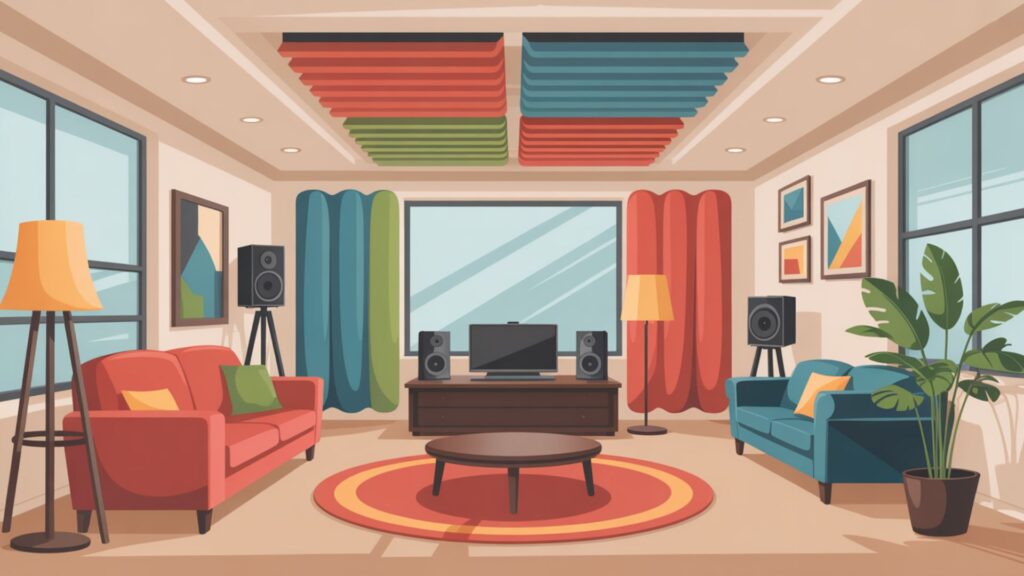I have been, or can be if you click on a link and make a purchase, compensated via a cash payment, gift, or something else of value for writing this post. As an Amazon Associate, I earn from qualifying purchases. Please read my full Affiliate Disclosure for more information.
Evaluating acoustics in a furnished space starts with quick measurements of reverberation time, background noise, and clarity. Identify reflection hotspots and flutter zones by listening to how reflections arrive after the direct sound. Use budget-friendly dampening: add absorbers at hotspots, diffuse surfaces, and consider modular panels or dense textiles with backing. Tailor tweaks for living rooms, offices, and media setups to balance speech intelligibility with warmth. Proven steps will guide you toward deeper, actionable insights.
Key Takeaways
- Identify primary sound issues (reverberation, reflections, background noise) and map problem areas with simple listening or sweeps.
- Use quick metrics (RT60, noise floor, clarity) and calibrated measurements to compare scenarios.
- Assess surfaces; prioritize absorption at reflection hotspots and diffusion to balance warmth and intelligibility.
- Choose budget-friendly treatments (mineral wool, dense textiles, DIY panels) placed away from corners and near reflective faces.
- Tailor solutions to room type (living room, office, media room) with modular panels, bass traps, and ceiling clouds as needed.
Understanding Room Acoustics: Key Concepts for Furnished Spaces

Understanding room acoustics starts with recognizing how sound behaves in furnished spaces: reflections, absorption, diffusion, and standing waves shape what you hear. In practical terms, you observe how surfaces alter signal energy: acoustic reflection directs sound paths, while sound absorption reduces reverberant energy. Diffusion scatters waves to prevent focal echoes, and standing waves create frequency hotspots or nulls if left unchecked. You should relate material choices, geometry, and surface treatments to these principles. By focusing on sound absorption and acoustic reflection, you assess how room features influence intelligibility, spatial impression, and bass balance, guiding informed dampening decisions for furnished environments.
Quick Measurements: Reverberation Time, Background Noise, and Clarity
Reverberation time, background noise, and clarity are essential metrics for quickly evaluating furnished spaces. You’ll perform short, objective measurements to compare scenarios and guide improvements. Use a standard reference signal and a calibrated microphone to capture decay curves and SPL levels, ensuring consistent results. Focus on sound absorption as a primary variable influencing reverberant decay, and apply acoustic calibration to translate measurements into actionable targets. Document RT60 estimates, background noise Floor levels, and speech intelligibility cues with precise thresholds. This approach enables rapid, repeatable assessments of room treatment options without overcomplication.
Spotting Problem Areas: Common Echoes and Flutter Issues
Spotting problem areas starts by isolating echoes that distort speech and music in furnished spaces. You identify echo hotspots where reflections converge, typically near parallel walls, large flat surfaces, or a distant hard boundary. Focus on onset timing, noting when reflected energy arrives within 20 to 50 milliseconds of the direct sound, which blurs clarity. Flutter zones emerge as rapid, periodic fluctuations in level and pitch, often caused by small, opposing surfaces. Map these regions with a simple sweep, listening for sustained flutter in mid to high frequencies. Targeted placement of absorptive or diffusive elements can reduce both echo hotspots and flutter zones.
Materials and Decor: Budget-Friendly Sound-Dampening Options
Even with a tight budget, you can substantially dampen sound by selecting practical materials and decor that prioritize absorption, diffusion, and boundary diffusion without breaking the bank. You’ll optimize room acoustics with targeted, low-cost options. Use DIY solutions that couple perforated panels or dense textiles with rigid backing to create effective impedance changes. Favor low cost materials like mineral wool, recycled cotton, or foam panels that maintain fire and fire-rated standards where required. Position absorptive items at reflection hotspots and away from corners. Combine diffusers and absorbers to balance clarity and warmth while maintaining aesthetic value and budget discipline.
Practical Tweaks for Different Rooms: Living Rooms, Offices, and Media Setups
When tailoring acoustics to specific spaces, start with room-specific goals and threat points: living rooms benefit from balanced absorption and diffusion to soften speech without dulling presence, offices require focused sound masking and draft control to reduce distraction, and media setups demand directional absorption plus low-reflection boundaries to preserve dialogue clarity and cinematic impact. In practice, implement targeted acoustic treatment with modular panels, bass traps, and ceiling clouds where needed. Use soundproofing techniques to separate ambient noise sources, seal gaps, and improve STC where feasible. Evaluate reflections with measurements, adjusting placement for *best* speech intelligibility and overall comfort.
Conclusion
You’ve learned how to evaluate acoustics in furnished spaces with practical, measurements-based steps. By estimating reverberation time, monitoring background noise, and checking clarity, you can identify problem areas like echoes or flutter. Apply budget-friendly dampening with strategic materials and decor, then tailor tweaks to living rooms, offices, and media setups. With precise diagnostics and targeted treatments, you’ll achieve balanced sound that supports conversation, focus, and multimedia enjoyment without sacrificing interior design.

Leave a Reply